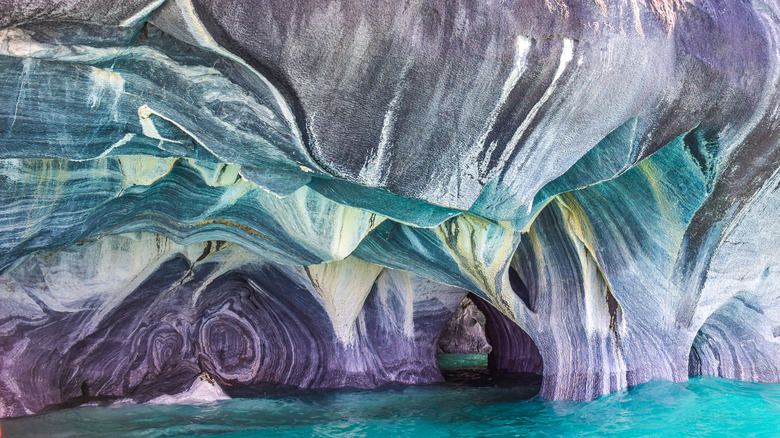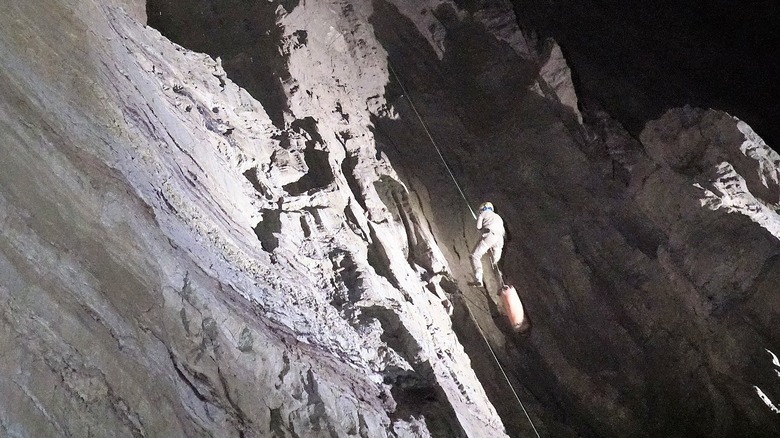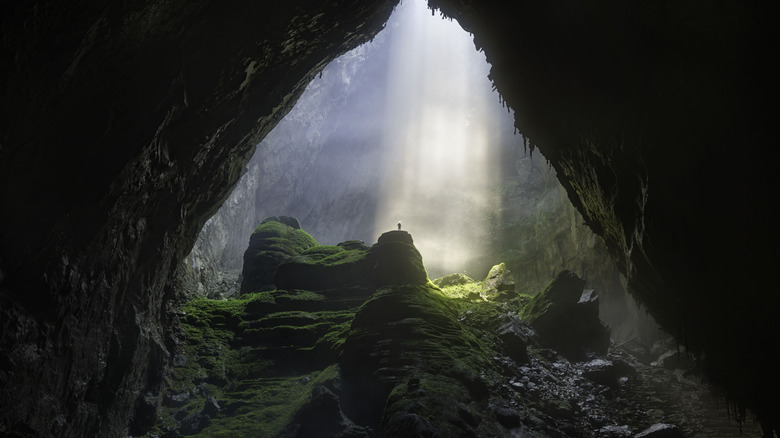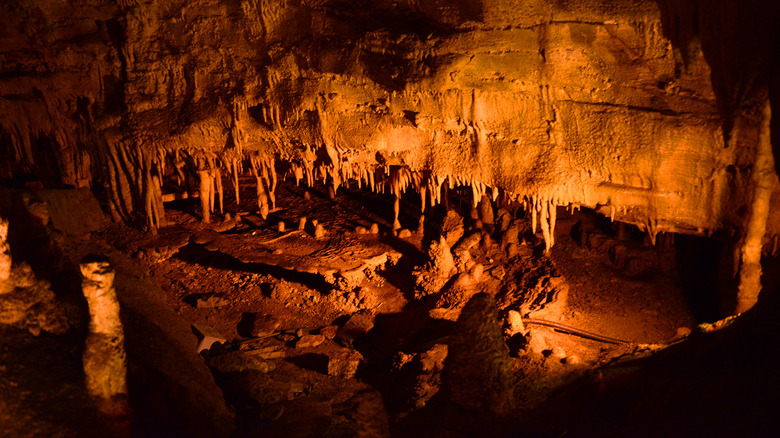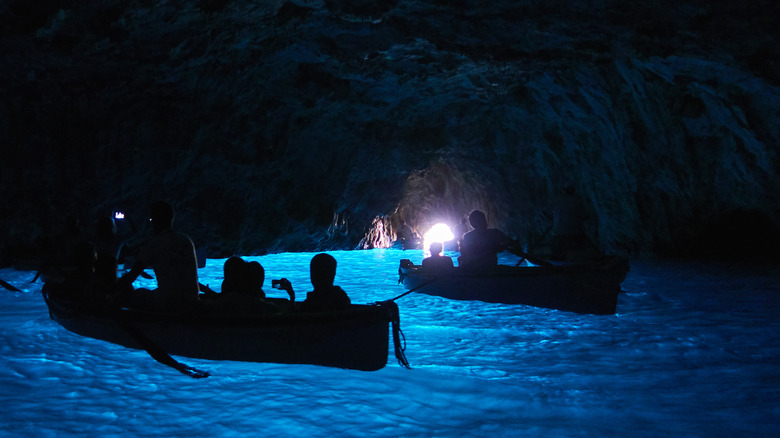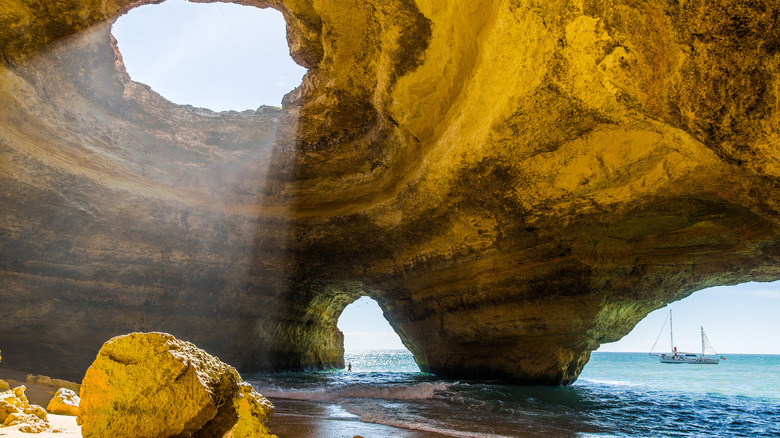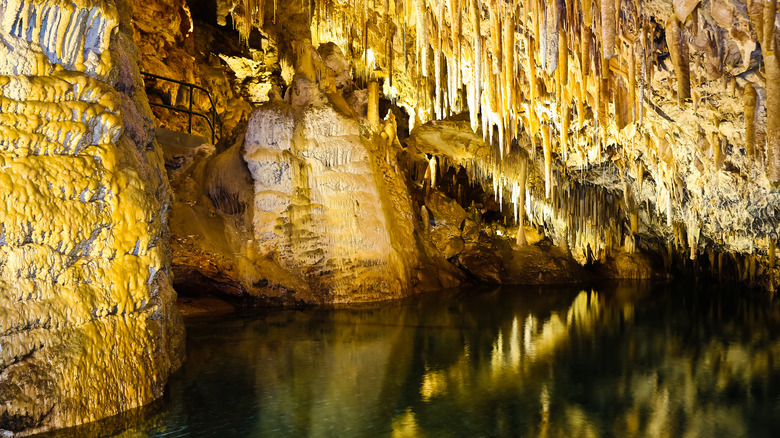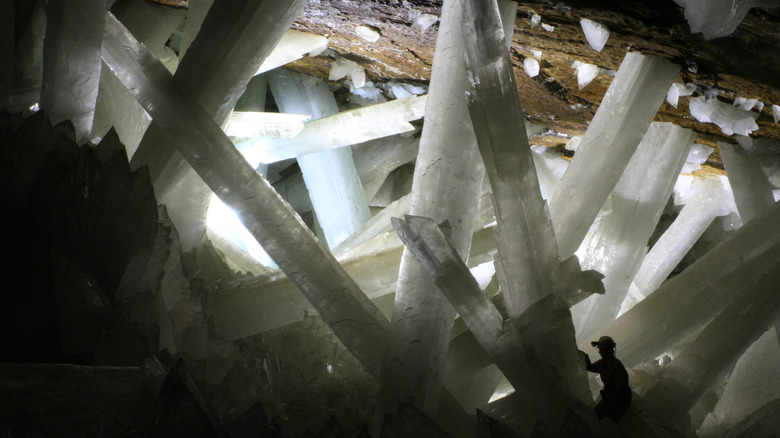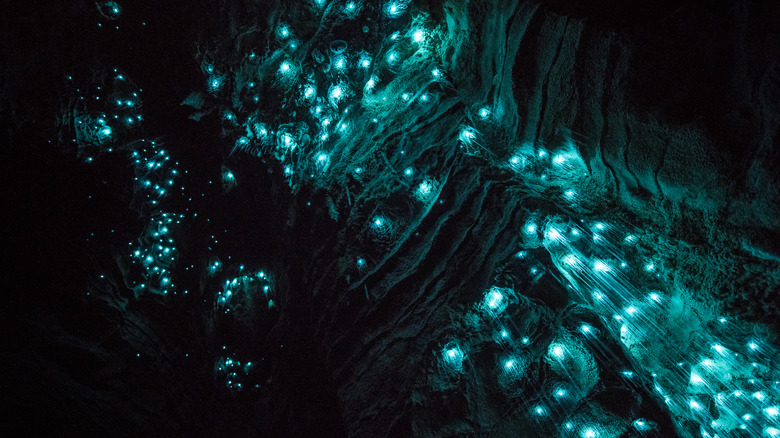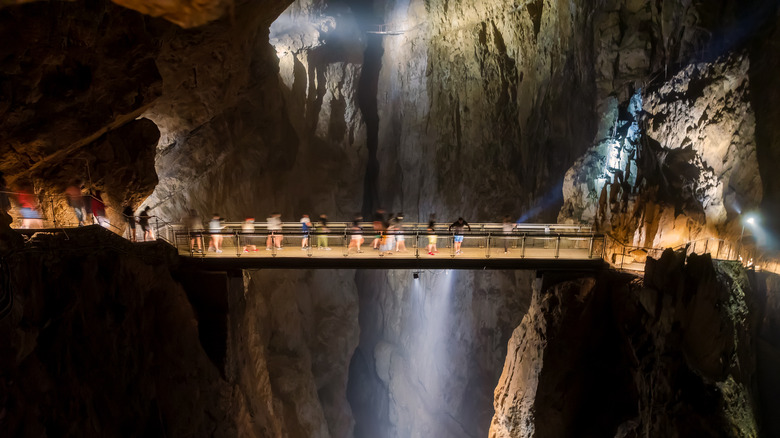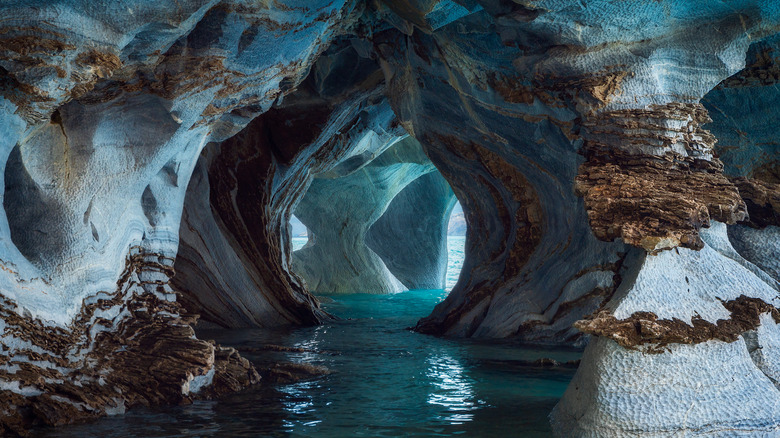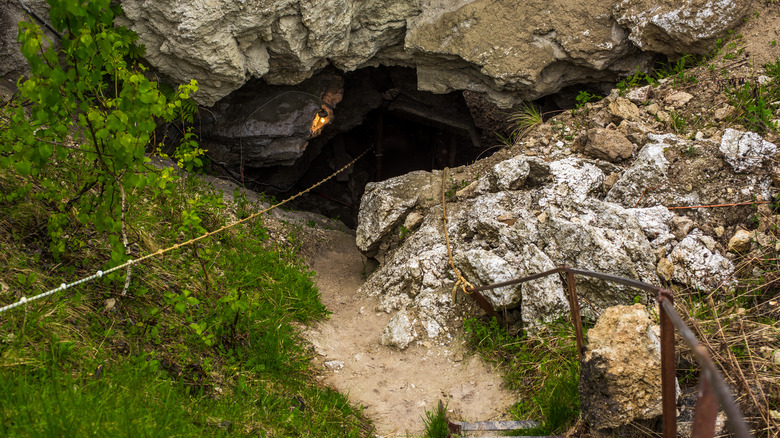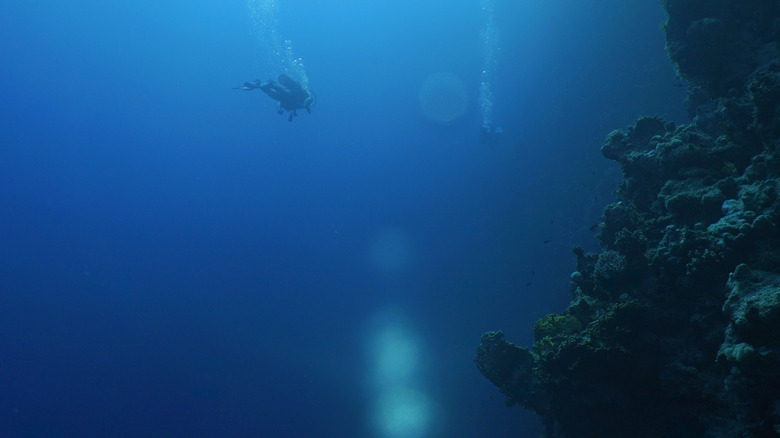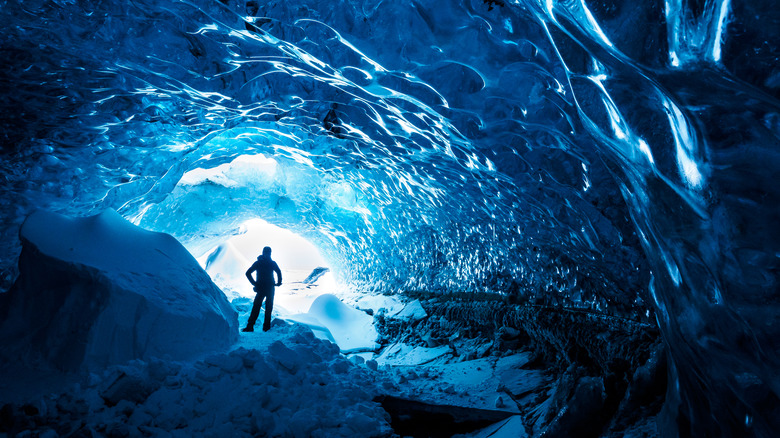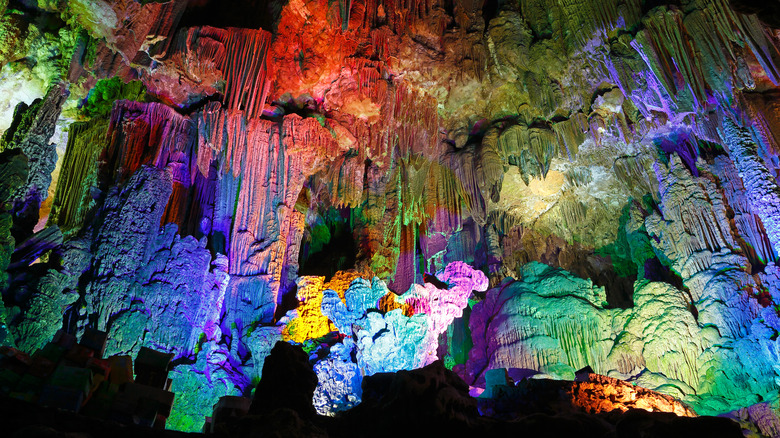The Most Incredible Caves Of The World
Caves have a special place in the imagination. To explorers, they are portals to secret worlds filled with fantastical shapes and creatures. It is no wonder that the Guardian points out that these natural formations are a central fixture of some of the most renowned literature in history. From the cave of the Cyclops Polyphemus in Homer's "Odyssey" to the Mines of Moria in J.R.R. Tolkien's "The Lord of the Rings," it is clear that these hidden worlds are meaningful to humanity at a core level.
What is also remarkable about caves is that there are perennially new ones being discovered, making spelunking truly one of the last bastions of exploration. And for those many caves that are known, they continue to attract spellbound visitors. So put on your Wellington boots and strap on your headlamp as we look at a selection of some of the most incredible caves in the world.
Veryovkina Cave
In 1999, the territory of Abkhazia broke away from the Republic of Georgia. According to Britannica, only Russia (which maintains a military presence there), along with a handful of other countries, recognizes its independence. The strip of territory, which lay as a narrow region along the Black Sea, features lowlands and mountain spurs. It also contains the world's deepest caves and the deepest of these is Veryovkina Cave.
Atlas Obscura informs us that the cave, located in the Arabika Massif of the Westerns Caucuses, descends down 1.3 miles under the Earth. The location itself, between Fortress and Umbrella Mountains, sounds — and is indeed — remote. In fact, the cave itself is a vertical cave system, which means that any exploration of it is like reverse mountaineering. At its lowest level, it flattens out into a catacomb of tunnels that have yet to be fully explored.
Exploring the cave is incredibly time-consuming. Even a professional cave explorer will take a week to plumb to the lowest depths of Veryovkina. National Geographic details one expedition that reached the deepest levels of the cave system. Along the way, they found what were new species of scorpions. Yet they had to terminate their stay since sudden floods drove them back to the surface. One of the cavers commented, "This is the pinnacle of human endeavor in the caving world."
Son Doong
In Phong Nha-Ke Bang National Park in the tropical forests of Vietnam is Son Doong, the largest cave system in the world. How large? CNN says Son Doong has over 1.35 billion cubic feet of space. The cave system features a swift-moving river, which was the ultimate tool that carved the canyon. It even features its own little jungle areas where streams of sunlight pierce in through openings where the ceiling had collapsed, called dolines (sinkholes). It is truly otherworldly.
Interestingly, Son Doong was completely undetected until 1990 when Ho Khanh, who was hunting, stumbled across it. However, after his initial discovery, he could not locate it again until 2009. Proper exploration began shortly thereafter. The cave opened to tourism in 2013, and it continues to be explored. Travel & Leisure, for example, notes that in 2019, cave divers found an underwater tunnel that connected the cave to another large system, thus expanding its official size even more.
How to visit this cave? Son Doong is very difficult to access since it is in a remote section of the Vietnamese jungle. However, for those of you who cannot mount an expedition, National Geographic has provided an interactive exploration of the cave system, which is awesome, but most likely pales in comparison to actually being there.
Mammoth Cave
One of the finest caves in the continental United States, and certainly one of the most renowned in the world, is Mammoth Cave in Kentucky. Maintained by the National Park Service, Mammoth Cave started forming between 10 to 15 million years ago as rain percolated through the surface to erode away a vast deposit of limestone. The result, as reported by Brittanica, is an 83 square mile cave system which at its longest, is at least 400 miles. This statistic makes it the longest known cave system in the world.
What's more, it is incredibly diverse as caves go. A caver would encounter canyon passages, tubes, vertical shafts, and wild natural formations of stalactites and stalagmites. The cave is also home to over 130 kinds of creatures, including troglobites, varieties of animals that only live in caves. While fossils have been found in the cave system, it earned its name not because remains of extinct pachyderms had been found inside, rather it references the size of the cave system itself. In addition, the National Park Service reports that humans have been visiting the caves for at least 5,000 years. In fact, there are over 1,000 archeological sites in the cave system. For these reasons, the site has been a UNESCO World Heritage site since 1981.
Mammoth Cave is highly accessible to the public. About 600,000 people visit Mammoth Park annually, of which 400,000 tour this glorious monument to nature.
Blue Grotto
In the Tyrrhenian Sea off the coast of Naples is the small and lovely island of Capri. This picturesque Mediterranean locale was a chosen refuge for the Roman Emperor Tiberius who, as reported by Ancient World Magazine, wished to escape the politics of Rome.
Atlas Obscura reports that one of the appeals of the island to the emperor may have been a secret seaside cave known as the Blue Grotto. The cave is only accessible by a small boat at low tide in which passengers must lie low while the vessel passes through an opening in the rock face. Upon passing through the narrow aperture it suddenly opens up. Passengers are awed by translucent blue waters which stand in contrast to the nearly 200-foot-high domed cave. The Romans apparently venerated this cave, since statues of the sea gods Neptune and Triton had been found there.
The Blue Grotto was long known to the locals of Capri as a place of evil spirits, but it became lost to general knowledge since the fall of Rome. However, according to Britannica, in 1826, it was rediscovered, becoming a place that awed the likes of Mark Twain and Hans Christian Anderson.
Benagil Sea Caves
It can be argued that the Benagil Sea Caves of Portugal are the most aesthetically pleasing set of caves in the world. Located in the Algarve region of the country, Atlas Obscura reports that this series of caves has been formed by the Atlantic through millennia of the surf pounding the limestone cliffs.
There are two points that make the Benagil Sea Caves so special. The first is that there are beaches inside the caves where visitors (by kayak and paddleboat only) can disembark onto the sand. Second, while on those beaches, visitors would experience the large apertures in the caves' roofs. These oculus-like features were caused by centuries of rainfall and allow light to pour into the caves creating rosettes of beautiful shadow against the surf.
Naturally enough, the cave is incredibly popular. Moon Portugal tells us that the Benagil Sea Caves are only accessible by water. However, regular tours depart from Benagil, which because of the natural beauty of the region has become a tourist mecca. The only downside is that on these tours, you can only pass through the caves and not lounge on the secret beach.
Crystal and Fantasy Caves
The island of Bermuda in the Caribbean is typically visited by tourists seeking to sit by the beach drinking daiquiris rather than plumb into the deepest depths of the Earth. However, two caves can be found on that island that stand out among the most beautiful in the world: Crystal and Fantasy Caves.
Conde Nast Traveler explains that the caves, some 120 feet deep, are narrow and filled with fantastical cave formations. Frommers tells us that visitors descend deep stairwells where they cross a pontoon bridge. This is the highlight of the tour since it crosses a subterranean lake where installed lights accentuate the natural beauty of the crystalline stalactites and stalagmites creating playful shadows. Apparently, these caves formed the basis for the design of the home of the Fraggles and Doozers in Jim Henson's "Fraggle Rock."
Considering that Bermuda is pretty tiny, it is surprising that Crystal and Fantasy Caves are a relatively recent discovery. In 1907, two boys stumbled upon them while trying to recover a lost ball.
Giant Crystal Cave
Under the Sierra de Naica Mountain in Chihuahua, Mexico is one of the most awe-inspiring gypsum caves in the world. The cave, located over 900 feet below the surface, was discovered in 2000 when, as reported by Chemical & Engineering News, miners stumbled upon it while seeking new ore deposits. Dubbed simply the Giant Crystal Cave, or Cave of the Crystals, How Stuff Works explains that the cave was formed by magma pushing up from the Earth's crust that chemically reacted with mineral forming gypsum crystals. This resulted in a cave system that has been rightfully compared to Superman's Fortress of Solitude. To give you an idea of the scale of these crystals, the longest are 36 feet long and over 3 feet thick. The singularly largest one is almost 40 feet long, over 13 feet thick, and weighs about 55 tons.
While the Giant Crystal Cave is definitely a sight to behold, only a few people have been able to visit it. This is because it is highly dangerous. Temperatures reach 113 Fahrenheit due to the magma right below and, because of groundwater, there is 100% humidity. These created conditions where explorers were prone to having fluid condense in their lungs, which can be fatal. Recent explorations pumped much of the groundwater out of the cave which made it less dangerous, but it also endangered the crystals. Since then, the water has been allowed to return.
Waitomo Glowworm Caves
The North Island of New Zealand offers one of the most enchanting visions combining geology and biology in the world. The name Waitomo Glowworm Caves describes exactly what these caves are about.
As Atlas Obscura details, these caves are mainly accessible via raft. In fact, the name Waitomo is Maiori for what CNN translates as "water passing through a hole." As the boats pass through into Waitomo, the dark vaults of the cave are lit up by what appear to be blue jewels. These fairy lights come from the bioluminescence of the many thousands of glowworms hanging from the ceilings. Glowworms, curiously enough are not a singular species, but, as explained by Britannica, can be one of several species of bioluminescent insects, usually larvae. In Waitomo, the primary species is arachnocampa luminosa. Thus, it is the bugs that make Waitomo so astounding.
You can imagine the reaction of British surveyor Fred Mace and Maori chieftain Tane Tinorau when they first discovered the cave in 1887. Tinorau later found an entrance to the caves via land. These caves are popular and accessible via small group tours that operate mainly during the Southern Hemisphere's summer.
Skocjan Caves
One cave system in Slovenia is so vast in scope that it has been called the "Underground Grand Canyon." Called Skocjan Caves, this cavern system features, according to the Skocjan Cave website, inner caverns with spans of up to 200 feet and 460 feet in height. The entire cave system is almost four miles in length. The system, formed over the course of thousands of years by the Reka River where it plunges underground features magnificent formations of stalagmites, which can be seen in such places as the Chamber of Rimstone Pools and the Great Chamber.
What also makes Skocjan Caves remarkable is, as reported by Smithsonian, its long history of human habitation. People have been using the caves for at least 5,000 years with evidence of it being a burial site. In fact, it is one of the oldest known caves mentioned by written sources, dating to the 2nd century BCE. Modern exploration of the caves did not begin until the 1800s and is continuing to this day. It is for these reasons that since 1986, the Skocjan Caves have been a UNESCO World Heritage site.
Cuevas de Mármol
In Patagonia, Chile near the Argentinean border there is a peninsula on a glacial lake made of marble that has formed some of the most marvelous caves in the world. According to Atlas Obscura, the Cuevas de Mármol (literally "Caves of Marble") were formed over a 5,000 year period as waters from Lake General Carrera eroded calcium carbonate. The result, as noted by Travel + Leisure, is a cave system of soft curves and multiple surfaces which exponentially enhances the light. The aesthetic qualities of the Cuevas de Mármol are such that it has also been nicknamed the "Marble Cathedral."
Yet seeing these caves is an adventure in and of itself. They are located some 120 outside of the city of Balmaceda which requires journeying over rough dirt roads. Then, even after you arrive, you need a boat since the caves are only accessible by water. Luckily there are ferries available from the nearby town of Chile Chico.
Orda Cave
Near the town of Orda, Russia there is an underwater cave that is considered by the diving community to be one of the most stunning. However, as reported by Diver, there is nothing remarkable about Orda Cave on the surface. It is frankly just a big hole. Yet when divers gear up and submerge themselves into the cave, they enter a wonderland. In fact, a local tongue-in-cheek myth holds that the Lady of Orda Cave inhabits the underwater caverns and watches over divers so long as they are righteous and pure of heart.
The caves are of white gypsum, which from the diver's viewpoint is stunning since the water itself is also exceedingly clear due to the gypsum's filtration of the water. Scuba Diver Life notes that a diver can see up to 150 feet. Yet the clear water is also one of the cave's biggest drawbacks. It is typically 40 degrees Fahrenheit, which means that cave divers must always wear very well insulated gear. When diving the Orda Cave, it seems endless to the diver, since it is the longest underwater cave in Russia at over 3 miles. In fact, it is not fully explored with new passages still being located in this underwater labyrinth. This is why Orda cave has become one of the most desired destinations for the cave diving community.
Blue Hole
The most dangerous cave dive in the world is the Blue Hole, found in the Gulf of Aqaba off the coast of Egypt. As reported by the Guardian, this nearly 400-foot sinkhole has been dubbed "the divers' cemetery." While it is unknown how many have died, some have estimated about 200 have paid the ultimate price in trying to plumb its depths.
The hazard does not prevent divers from flocking to the site, but not, as ABC News maintains, because of any inherent beauty of the cave. Rather, it is the allure of sudden death. This has particularly been the case with freedivers, those divers who try to descend into the cave on a single breath. Perhaps the most deadly spot is the so-called "arch" at a depth of just over 170 feet. Here the cave opens up to an 85-foot-long tunnel that cuts through the reef and into the open sea. Memorial stones litter the site. The Blue Hole of Aqaba is the Mount Everest of cave dives.
Crystal Caves
When most people think of caves, limestone, gypsum, and all kinds of minerals come to mind. Yet the Crystal Caves of Iceland are uniquely made of the commonest crystal: ice. National Geographic's Complete National Parks of Europe says that the Vatnajökull national park covers 14% of Iceland. It is a place of raw nature where lava fields are adjacent to the magnificent Vatnajökull glacier.
The glacier, which is difficult to access without professional knowledge or assistance, is riven with numerous ice caves. These were formed, according to "Winter Tourism," when summer melting caused ice melt rivers that ate into the glacier. It is for that reason that the Crystal Caves are only safe to visit during winter when it is all frozen up. But even then there is danger. As Iceland Magazine reported in 2018, an experienced guide died in the caves because of the release of poisonous geothermal gasses. It is common for those entering the Crystal Caves to carry a gas monitor.
Still, the danger of the ice caves and the discomfort of visiting Iceland during the winter are made up for by the experience. Each descent into one of these caverns offers a journey into a bluish translucent world that could have come out of the sagas of Norse mythology.
Reed Flute Cave
Located near the city of Guilin, the Reed Flute Cave is possibly the best attraction for cavers in the country of China. The cave, Atlas Obscura tells us, was given its name for the reeds that grow near the entrance which were often converted to flutes. As for the interior, it is a showcase of a diversity of geologic formations. These are so inspiring that humans have been visiting the Reed Flute Cave since at least 792 CE, the time of the Tang Dynasty. Curiously, the cave had fallen out of memory in recent centuries and was only rediscovered by refugees who were escaping from the Japanese during World War II. One can only imagine their wonder upon stumbling inside.
Today, the cave is highly commercialized. Frequent tours come through and are treated to an array of neon lights, which are meant to enhance the geologic features of the cave. As pointed out by National Geographic's China travel guide, the overt exploitation of the Reed Flute Cave by tour groups evaporates some of its allure. They recommend going in alone if you can.
